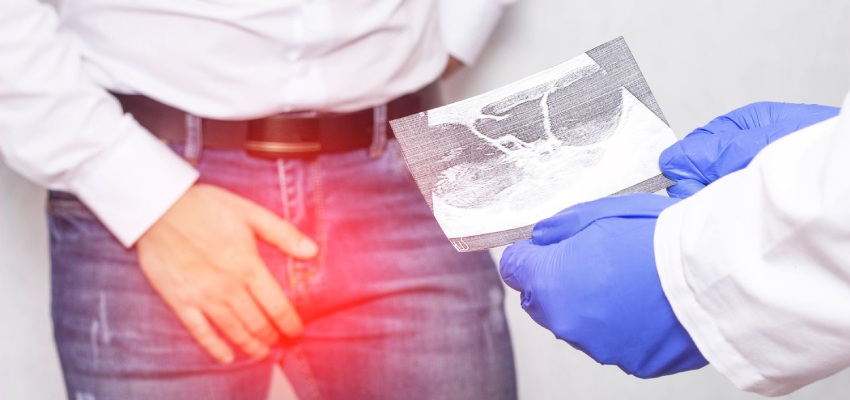Hydrocele is a condition in which a fluid filled sac is formed in the scrotum. It is found most commonly in infants. Hydrocele can go away on its own but if hydrocele doesn’t disappear then one may undergo surgery. Hydrocele can be present at one side or both sides of the scrotum.
One may feel a lot of difficulty due to its swelling and discomfort. The types of hydrocele are many and they require specific treatment. In this blog we are going to talk about hydrocele medical tests and about all the things related to hydrocele.
Symptoms and types are also discussed in this blog. Keep reading and know the things about hydrocele by reading further sections. Treatment methods and complications are also mentioned that can be checked.
Different Symptoms of hydrocele
Although the symptoms can be different depending upon the type of hydrocele, some of the main symptoms that are noticed by individuals are mentioned as follows. Common symptoms include.

- Swelling that can cause pain.
- Discomfort in the area.
- Pain occurs in the localised area.
- The area may feel heavy to the individual.
- Difficulty in doing normal activities.
- Irritation due to pain.
- Frustration may happen.
ALL of these are common symptoms of hydrocele and one needs to get in touch with a doctor for its treatment.
Have a look at keratin treatment cost.
Types of hydrocele to know
There are two main types of hydrocele. Both of the types are mentioned here and you can check them out. The two types of hydrocele that are present are shared as follows.
- Communicating hydroceles are the hydroceles that are connected to the fluid of the abdomen. They are formed during the foetal stage. The fluids of the abdomen are connected to fluids of hydrocele. The size of this type of hydrocele is large and it creates difficulty.
- Non communicating hydrocele is a hydrocele that is not connected via fluids to the abdomen. The size of this type of hydrocele remains the same.
On the basis of type doctors can give different treatment to the patient. Diagnosing hydroceles is done via different methods.
Diagnosis of hydrocele
Different kinds of medical tests are performed by doctors for diagnosing hydrocele. In this section we have shared some of the known hydrocele medical tests. The hydrocele medical tests are shared as follows.

- Computed tomography or CT scan is performed for diagnosing the hydrocele. In this 3D images of testicles are made which help in better and accurate diagnosis.
- Pelvic ultrasound is the most common test that is performed for its diagnosis. Doctors take help from this test to better understand the problem better.
These medical tests are performed for hydroceles to understand it better. After diagnosis proper treatment is given.
Read about – Lasik eye surgery cost
Treatment for hydrocele
The treatment for hydrocele is done according to the needs of the individual. The different treatment options are shared as follows.
- If a hydrocele is showing no symptoms in adults then it can be left untreated.
- Surgeries are performed when the hydrocele is very large and heavy. The removal of hydrocele is done in those cases.
- Doctors may drain the hydrocele with a syringe or needle. In this method the recurrence can happen.
- Sclerotherapy is done to prevent the recurrence.
Treatment methods are given to individuals by doctors after understanding the case.
Complications of hydrocele
The complications of hydrocele can occur in case it is left untreated. The main complications of hydrocele are shared as follows.

- Irritation may get worse.
- One may feel intense pain.
- The hydrocele may push into the abdomen.
- Medical complications can occur.
It is best to get rid of hydrocele by doing proper treatment.
Here is Plastic surgery cost in India.
Prognosis for hydrocele
Hydrocele is a condition that consists of fluid filled sacs in scrotum. The swelling can bring difficulty. It is important to take care of diagnosis and to get proper treatment.
In some cases it can be left untreated but in some surgery is performed. Doctors can advise on the suitable treatment after diagnosing properly.
Risk factor of hydrocele
The risk factors of hydrocele are many and one can check them by reading the points below.

- Hydrocele can be formed in those individuals who are exposed to some previous inflammation and injury.
- This can be formed in infants during birth.
- Infections can also be a risk factor of hydrocele.
All these are risk factors of hydrocele.
Also read about – Cataract surgery cost in Bangalore
Side effects of hydrocele surgery
The surgery of hydrocele might have some side effects. The side effects are shared as follows.
- The risk of anaesthesia.
- Infection can occur.
- Swelling may happen.
- Bruising can occur.
- In some cases recurrence can happen of hydrocele.
Side effects like these are common but consultation is to be done with a doctor for better results.
Pre or post care of hydrocele
Pre or post care tips of hydrocele are shared and it’s important to pay attention to it. The main pre or post care tips that one should follow are shared as follows.

- It is best to treat any inflammation or injury at earliest possible.
- Make sure that you are following good hygiene.
- Consult a doctor immediately in case of problems related to the groin region.
- After treatment one should take care of health by proper diet.
- Follow up sessions are to be taken care of.
- Diet filled with fresh fruits and vegetables is to be consumed.
All these tips can help in getting good recovery. Make sure that you are following all these tips along with proper treatment.
Explore more about – Bariatric surgery in Bangalore
Treatment Cost of Hydrocele in India
Treatment of hydrocele in India is available and many doctors and hospitals are capable of providing good treatment. One can simply consult a good doctor by doing a thorough research.
Medical tests of hydrocele like CT scan or ultrasound are performed at affordable prices. One can get in touch with a good doctor for the treatment of hydrocele.
The acreage cost for treatment of hydrocele in India is Rs 25,000 to Rs 85,000. The cost can vary and it is based upon many factors like the condition of the patient, hospital locality, surgery interventions, etc.